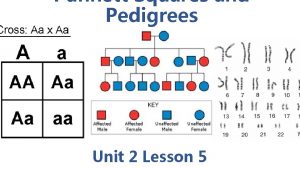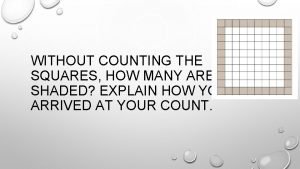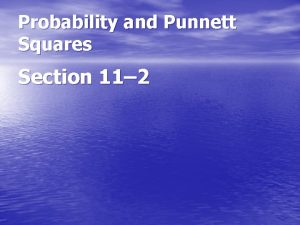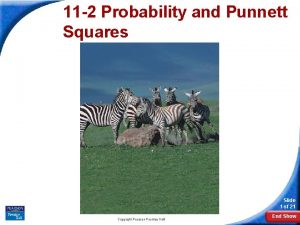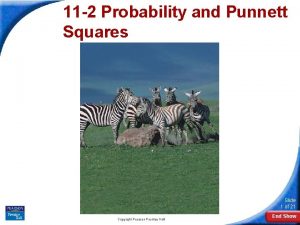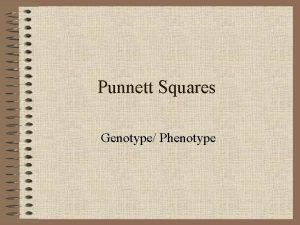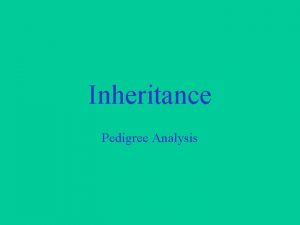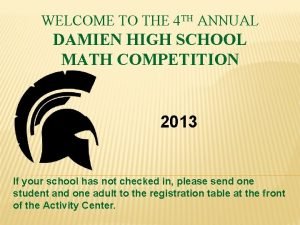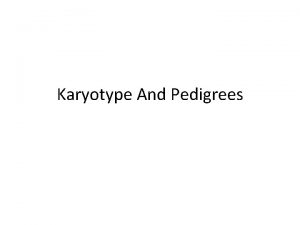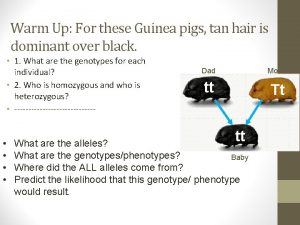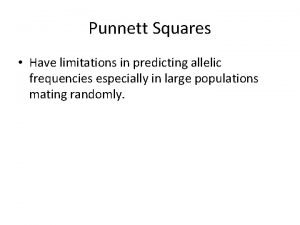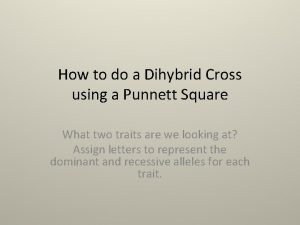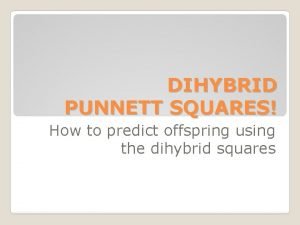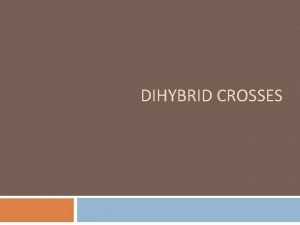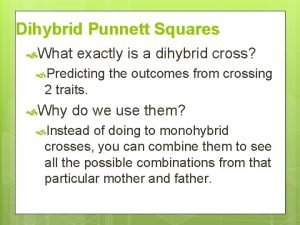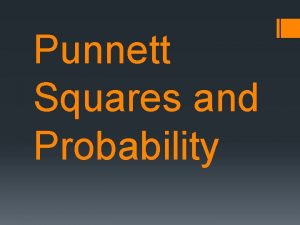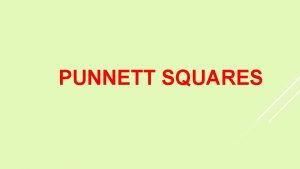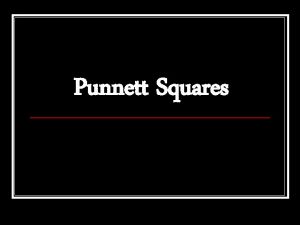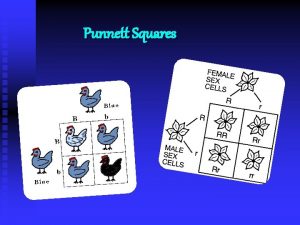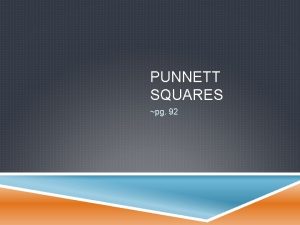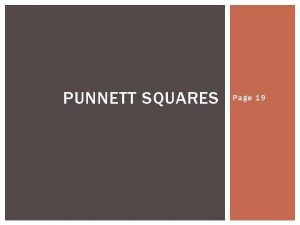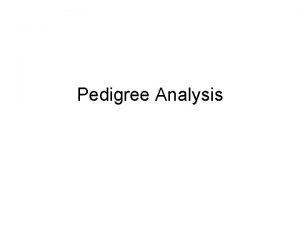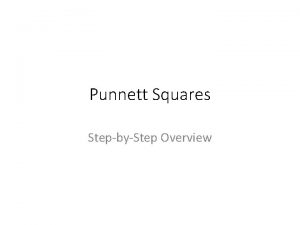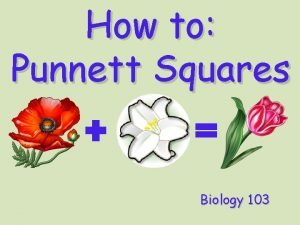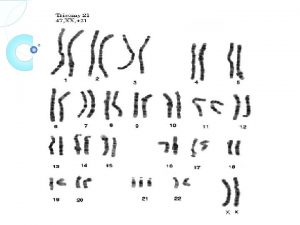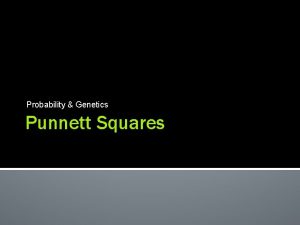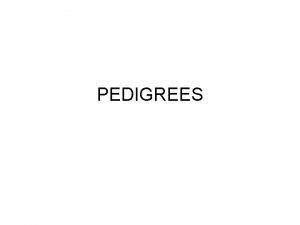Pedigree Analysis Why do Pedigrees Punnett squares and
























- Slides: 24

Pedigree Analysis

Why do Pedigrees? • Punnett squares and chi-square tests work well for organisms that have large numbers of offspring and controlled matings, but humans are quite different: 1. small families. Even large human families have 20 or fewer children. 2. Uncontrolled matings, often with heterozygotes. 3. Failure to truthfully identify parentage.

Goals of Pedigree Analysis • 1. Determine the mode of inheritance: dominant, recessive, partial dominance, sex-linked, autosomal, mitochondrial, maternal effect. • 2. Determine the probability of an affected offspring for a given cross.

Basic Symbols

More Symbols

Y-Linked Inheritance • We will now look at how various kinds of traits are inherited from a pedigree point of view. • Traits on the Y chromosome are only found in males, never in females. • The father’s traits are passed to all sons. • Dominance is irrelevant: there is only 1 copy of each Y-linked gene (hemizygous).

Mitochondrial Genes • Mitochondria are only inherited from the mother. • If a female has a mitochondrial trait, all of her offspring inherit it. • If a male has a mitochondrial trait, none of his offspring inherit it. • Note that only 1 allele is present in each individual, so dominance is not an issue.

Outsider Rules • In any pedigree there are people whose parents are unknown. These people are called “outsiders”, and we need to make some assumptions about their genotypes. • Sometimes the assumptions are proved wrong when the outsiders have children. Also, a given problem might specify the genotype of an outsider. • Outsider rule for dominant pedigrees: affected outsiders are assumed to be heterozygotes. • Outsider rule for recessive pedigrees: unaffected (normal) outsiders are assumed to be homozygotes. • Both of these rules are derived from the observation that mutant alleles are rare.

Maternal Effect Genes • The maternal effect rule: “Mother’s genotype determines offspring’s phenotype. ” • Assume that the trait is recessive, in a complete dominance situation. • Also assume all “outsiders” (people with unknown parents) are homozygous for the allele they are expressing : the dominant allele if they are unaffected, and the recessive allele if they are affected.

Sex-Influenced Trait • Assume that the trait is dominant in males but recessive in females. • Assume all outsiders are homozygotes. • Thus: – DD is always affected – dd is always normal – Dd is affected in males, but normal in females

Sex-Limited Trait • There are several possibilities for dominance, but for this problem assume the trait is dominant but only expressed in males. • Affected outsider males are heterozygous; unaffected males are homozygous normal • Assume that outsider females are homozygous normal.

Sex-Linked Dominant • Mothers pass their X’s to both sons and daughters • Fathers pass their X to daughters only. • Normal outsider rule for dominant pedigrees for females, but for sex-linked traits remember that males are hemizygous and express whichever gene is on their X. • XD = dominant mutant allele • Xd = recessive normal allele

Sex-Linked Recessive • males get their X from their mother • fathers pass their X to daughters only • females express it only if they get a copy from both parents. • expressed in males if present • recessive in females • Outsider rule for recessives (only affects females in sexlinked situations): normal outsiders are assumed to be homozygous.

Autosomal Dominant • Assume affected outsiders are assumed to be heterozygotes. • All unaffected individuals are homozygous for the normal recessive allele.

Autosomal Recessive • All affected are homozygotes. • Unaffected outsiders are assumed to be homozygous normal • Consanguineous matings are often (but not always) involved.

Large Pedigrees • We are now going to look at detailed analysis of dominant and recessive autosomal pedigrees. • To simplify things, we are going to only use these two types. • The main problems: 1. determining inheritance type 2. determining genotypes for various individuals 3. determining the probability of an affected offspring between two members of the chart.

Dominant vs. Recessive • Is it a dominant pedigree or a recessive pedigree? • 1. If two affected people have an unaffected child, it must be a dominant pedigree: D is the dominant mutant allele and d is the recessive wild type allele. Both parents are Dd and the normal child is dd. • 2. If two unaffected people have an affected child, it is a recessive pedigree: R is the dominant wild type allele and r is the recessive mutant allele. Both parents are Rr and the affected child is rr. • 3. If every affected person has an affected parent it is a dominant pedigree.

Dominant Autosomal Pedigree I 2 1 II 1 2 3 4 5 6 III 1 2 3 4 5 6 7 8 9 10

Assigning Genotypes for Dominant Pedigrees • 1. All unaffected are dd. • 2. Affected children of an affected parent and an unaffected parent must be heterozygous Dd, because they inherited a d allele from the unaffected parent. • 3. The affected parents of an unaffected child must be heterozygotes Dd, since they both passed a d allele to their child. • 4. Outsider rule for dominant autosomal pedigrees: An affected outsider (a person with no known parents) is assumed to be heterozygous (Dd). • 5. If both parents are heterozygous Dd x Dd, their affected offspring have a 2/3 chance of being Dd and a 1/3 chance of being DD.

Recessive Autosomal Pedigree

Assigning Genotypes for Recessive Pedigrees • 1. all affected are rr. • 2. If an affected person (rr) mates with an unaffected person, any unaffected offspring must be Rr heterozygotes, because they got a r allele from their affected parent. • 3. If two unaffected mate and have an affected child, both parents must be Rr heterozygotes. • 4. Recessive outsider rule: outsiders are those whose parents are unknown. In a recessive autosomal pedigree, unaffected outsiders are assumed to be RR, homozygous normal. • 5. Children of RR x Rr have a 1/2 chance of being RR and a 1/2 chance of being Rr. Note that any siblings who have an rr child must be Rr. • 6. Unaffected children of Rr x Rr have a 2/3 chance of being Rr and a 1/3 chance of being RR.

Conditional Probability • Determining the probability of an affected offspring for most crosses is quite simple: just determine the parents’ genotypes and follow Mendelian rules to determine the frequency of the mutant phenotype. • In some cases, one or both parents has a genotype that is not completely determined. For instance, one parent has a 1/2 chance of being DD and a 1/2 of being Dd. • If the other parent is dd and this is a dominant autosomal pedigree, here is how to determine the overall probability of an affected phenotype: 1. determine the probability of an affected offspring for each possible set of parental genotypes. 2. Combine them using the AND and OR rules of probability

Conditional Probability, Pt. 2 • In our example, one parent has a 1/2 chance of being Dd and a 1/2 chance of being DD, and the other parent is dd. • There are thus 2 possibilities for the cross: it could be DD x dd, or it could be Dd x dd. We have no way of knowing for sure. • If the cross is DD x dd, all the offspring as Dd, and since the trait is dominant, all are affected. • On the other hand, if the cross is Dd x dd, ½ the offspring are Dd (affected) and ½ are dd (normal). • So, there is a ½ chance that the mating is DD x dd, with all offspring affected, and a ½ chance that the mating is Dd x dd, with ½ the offspring affected. • Or: (1/2 * 1) + (1/2 * 1/2) = overall probability • = 1/2 + 1/4 =3/4

Another Example • More complicated: in a recessive pedigree, one parent has a ½ chance of being RR and a ½ chance of being Rr, while the other parent has a 1/3 chance of being RR and a 2/3 chance of being Rr. • In this case there are 4 possible matings: 1. There is a 1/2 * 1/3 = 1/6 chance that the mating is RR x RR. In this case, 0 offspring will be affected (rr). 2. There is a 1/2 * 2/3 = 2/6 = 1/3 chance that the mating is RR x Rr. In this case, none of the offspring are affected. 3. There is a 1/2 * 1/3 = 1/6 chance that the mating is Rr x RR. In this case, no offspring will be affected (rr). 4. There is a 1/2 * 2/3 = 1/3 chance that the mating is Rr x Rr. In this case, 1/4 of the offspring will be affected (rr). • Combining all possibilities: (1/6 * 0 ) + (1/3 * 0) + (1/6 * 0) + (1/3 *1/4) = 0 + 0 + 1/12 = 1/12
 Pedigree punnett square
Pedigree punnett square Youcubed squares and more squares answers
Youcubed squares and more squares answers Section 11-2 probability and punnett squares
Section 11-2 probability and punnett squares 11-2 probability and punnett squares
11-2 probability and punnett squares Section 11-2 probability and punnett squares
Section 11-2 probability and punnett squares 11-2 probability and punnett squares answer key
11-2 probability and punnett squares answer key Punnett square percentages
Punnett square percentages What do squares represent in a pedigree
What do squares represent in a pedigree Hey hey bye bye
Hey hey bye bye 4 squares = 5 9 squares =
4 squares = 5 9 squares = The karyotypel has a turner syndrome
The karyotypel has a turner syndrome H h
H h Whats a karyotype
Whats a karyotype Pea plant punnett squares worksheet answer key
Pea plant punnett squares worksheet answer key Sex linked chromosome punnett square
Sex linked chromosome punnett square Punnett square
Punnett square Hh h hh punnett square
Hh h hh punnett square Foil punnett square
Foil punnett square Foil method for punnett squares
Foil method for punnett squares Foil method in genetics
Foil method in genetics Eye color punnett squares
Eye color punnett squares Codominance punnett square
Codominance punnett square Blood type punnett square problems
Blood type punnett square problems Sex linked traits punnett square
Sex linked traits punnett square Phenotype punnett square
Phenotype punnett square
